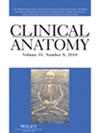The Discovery of the Hemangioblast: An Historical Note.
IF 2.3
4区 医学
Q1 ANATOMY & MORPHOLOGY
引用次数: 0
Abstract
Florence R. Sabin and P. D. F. Murray first proposed that both the endothelial and hematopoietic lineages are derived from a common precursor, the "hemangioblast" in the blood islands of the yolk sac. In the course of time, data from avian, mice, and human embryos consistently show a close association between endothelial and hematopoietic compartments. These findings confirm that a common precursor or "hemangioblast" is conserved between species during early development.
血管母细胞的发现:一个历史注释。
Florence R. Sabin和P. D. F. Murray首先提出,内皮细胞和造血细胞谱系来源于一个共同的前体,即卵黄囊血岛中的“成血管细胞”。随着时间的推移,来自禽类、小鼠和人类胚胎的数据一致表明内皮细胞和造血室之间存在密切联系。这些发现证实了一种共同的前体或“血管母细胞”在物种之间的早期发育中是保守的。
本文章由计算机程序翻译,如有差异,请以英文原文为准。
求助全文
约1分钟内获得全文
求助全文
来源期刊

Clinical Anatomy
医学-解剖学与形态学
CiteScore
5.50
自引率
12.50%
发文量
154
审稿时长
3 months
期刊介绍:
Clinical Anatomy is the Official Journal of the American Association of Clinical Anatomists and the British Association of Clinical Anatomists. The goal of Clinical Anatomy is to provide a medium for the exchange of current information between anatomists and clinicians. This journal embraces anatomy in all its aspects as applied to medical practice. Furthermore, the journal assists physicians and other health care providers in keeping abreast of new methodologies for patient management and informs educators of new developments in clinical anatomy and teaching techniques. Clinical Anatomy publishes original and review articles of scientific, clinical, and educational interest. Papers covering the application of anatomic principles to the solution of clinical problems and/or the application of clinical observations to expand anatomic knowledge are welcomed.
 求助内容:
求助内容: 应助结果提醒方式:
应助结果提醒方式:


